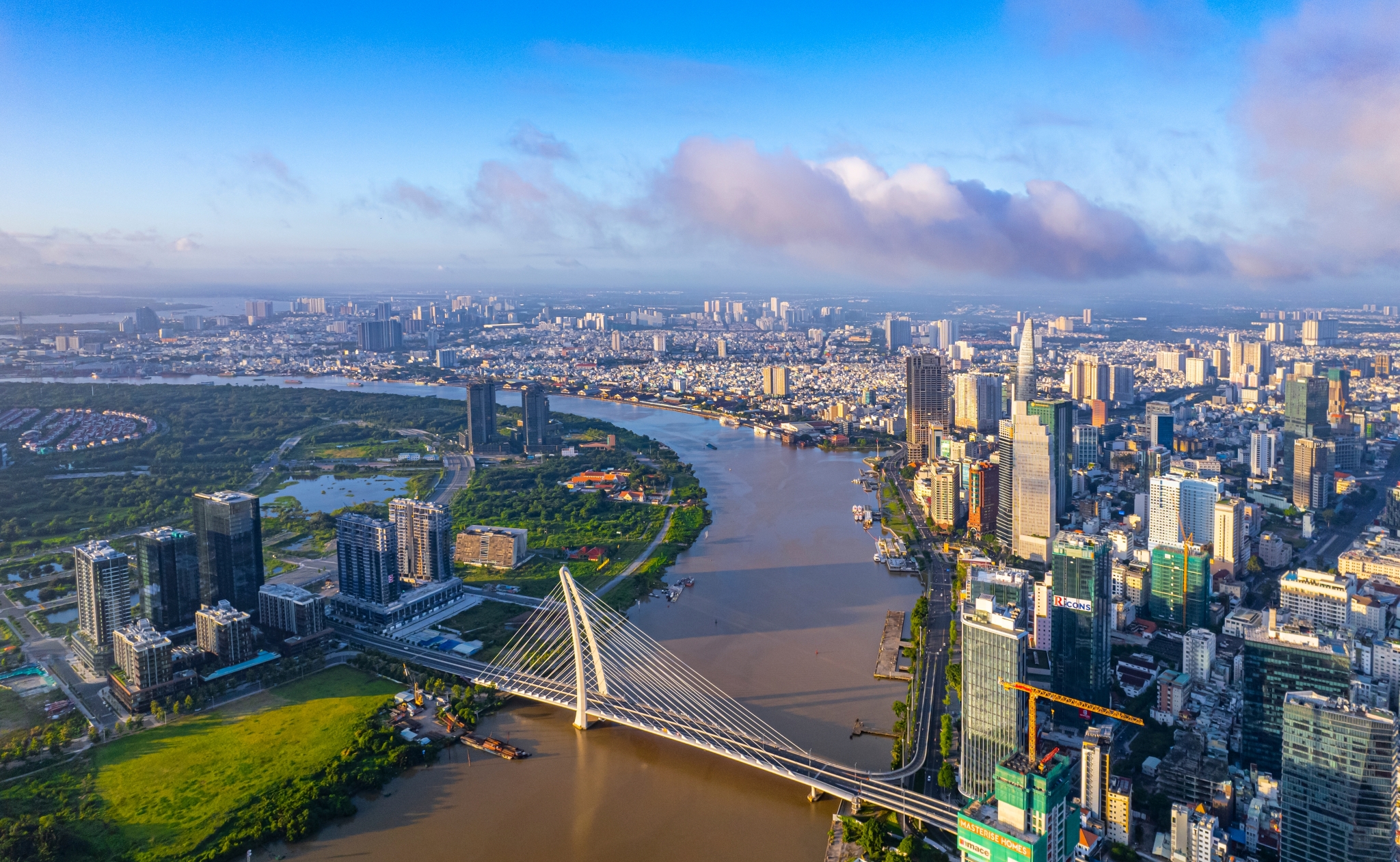TRANSFORMING THU THIEM PENINSULA: ONE FUTURE HUB OF HO CHI MINH CITY
Thu Thiem Peninsula, with its prime location on the eastern bank of the Saigon River in Thu Duc City (formerly District 2), is set to become the nucleus of Ho Chi Minh City’s economic and urban development. The city has identified this 7.37-square-kilometer peninsula, first earmarked for development in 1996, as its new financial, commercial, and high-end service center. The strategic infrastructure plan, involving five bridges and a tunnel, aims to seamlessly integrate Thu Thiem with the central business districts, catalyzing economic growth and urban transformation.
To date, Thu Thiem is accessible via two bridges and one tunnel, with additional projects underway to further reinforce transportation. The comprehensive infrastructure plan includes the construction of Thu Thiem Bridges 3 and 4 and a pedestrian bridge over the Saigon River, which will significantly bolster the peninsula’s accessibility and attractiveness.
Thu Thiem Bridge 1
Inaugurated in 2008, Thu Thiem Bridge 1 was the first major project to connect the peninsula with the city center. This 1.2 km bridge, linking Ngo Tat To and Nguyen Huu Canh streets in Binh Thanh District to Nguyen Co Thach Street in Thu Thiem, was built with an investment of approximately 1,500 billion VND. The six-lane bridge has been instrumental in alleviating traffic congestion on the Saigon Bridge while simultaneously attracting substantial investment, marking the beginning of Thu Thiem’s evolution into a modern urban center.

Thu Thiem Tunnel
Opened in 2011, the Thu Thiem Tunnel, also known as the Saigon River Tunnel, is a critical infrastructure project connecting Thu Thiem with District 1. This 1.5-kilometer tunnel begins from Mai Chi Tho Boulevard in Thu Thiem to Vo Van Kiet Avenue in District 1, constructed with an investment of over 1 billion USD. It plays a pivotal role in connecting Thu Duc City with the central districts, improving traffic flow, and supporting economic activities in districts 1, 4, and 5.
Ba Son Bridge (Thu Thiem Bridge 2)
Ba Son Bridge, formerly known as Thu Thiem Bridge 2, represents the third major connection between the peninsula and the city center. Completed in 2020, this 1.4 km bridge, costing over 3,000 billion VND, links Ton Duc Thang Street in District 1 to Thu Thiem New Urban Area. Ba Son Bridge stands as an architectural and infrastructural landmark, boosting property values in its vicinity and integrating high-end real estate developments into the metropolis fabric.

Thu Thiem Bridge 3
Ideally positioned 1.3 km downstream from Ba Son Bridge, Thu Thiem Bridge 3 will connect the peninsula with District 4. This bridge will link the Nha Rong-Khanh Hoi port area to Thu Thiem New Urban Area, with the project currently in the proposal phase. Once completed, it will facilitate smoother traffic flow and bolster commercial activities between these key districts.
Thu Thiem Bridge 4
Approximately 4.5 km from Thu Thiem Bridge 1, Thu Thiem Bridge 4 is planned to connect the peninsula with South Saigon’s established, affluent multi-functional communities and industrial zones. This bridge will be critical in reducing traffic congestion on key routes like Ton Duc Thang Street, Nguyen Tat Thanh Street, and Khanh Hoi Bridge, while fostering economic synergy between Thu Duc City and South Saigon. Its design, featuring a central span that can be raised or lowered, is inspired by the Jacques Chaban-Delmas Bridge in Bordeaux, France, allowing for maritime traffic to pass underneath.
The project, set to commence in 2024 and conclude by 2028, involves a substantial investment of approximately 6,030 billion VND. Starting at Nguyen Van Linh Street near the Tan Thuan 2 Bridge in District 7 and ending at Nguyen Ci Thạch Street in Thu Duc City, Thu Thiem 4 spans 2.16 kilometers, with a 1.6-kilometer bridge structure and six traffic lanes. Additionally, it will facilitate the use of international passenger terminals at the Nha Rong – Khanh Hoi port area, further boosting tourism.
Saigon River Pedestrian Bridge
The planned pedestrian bridge over the Saigon River, situated between Ba Son Bridge and the Thu Thiem Tunnel, will further enhance Thu Thiem’s connectivity. This bridge, extending over 500 meters, will connect Thu Thiem’s riverfront park with Bach Dang Wharf Park, featuring an architectural design inspired by the symbolic water coconut leaf. It aims to provide both functional connectivity and a scenic pedestrian route.

Vision for an Integrated Future
The completion of these infrastructural projects will create a comprehensive transportation network, fully integrating Thu Thiem Peninsula with Ho Chi Minh City’s central districts. This integration is expected to drive significant economic growth, elevate living standards, and attract both local and international investments.
The synchronization of infrastructure with urban planning in Thu Thiem will serve as a catalyst for its transformation into a dynamic economic center. The tactical development of Thu Thiem underscores the commitment to creating a vibrant, interconnected landscape that propels Ho Chi Minh City into a future marked by economic dynamism and infrastructural excellence.
The vision for Thu Thiem Peninsula is clear: to reform it into a thriving residential hub that not only meets the current demands of the city but also anticipates future growth and development needs. The planned infrastructure will not only strengthen connectivity but also position Thu Thiem as a cornerstone of Ho Chi Minh City’s economic and urban strategy, paving the way for a modern, sustainable, and prosperous future.
Get professional insights in property sales, residential leasing and asset management services for your investment in Vietnam, reach our Residential Services team at rs@arcadia-consult.com.vn

